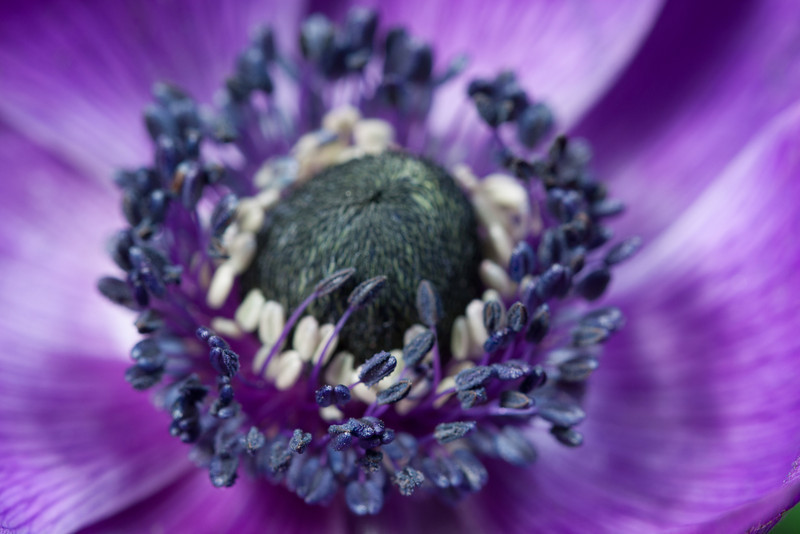Since there has been a bit of discussion of focus stacking recently, I thought it might be helpful to post an example, pointing out some of the issues that have been raised.
First, here is the final image of an anemone:
I shot this last night with my 50D and a 100mm macro. All shots were f/7.1. Lighting was two halogen floods in hair lights, one with a diffuser and one using an umbrella. There were 11 images, which I stacked using Zerene. I used the DMap algorithm, which is slower than PMax and supposedly preserves a bit less detail, because I have found that DMAP does much better at preserving colors and textures. It has a bit of editing in Lightroom after stacking.
The following two images are the first and last in the stack:
You can see that even at f/7.1 (at close to minimum working distance), DOF covers very little of the image, particularly because it is a deep subject, and I have it deliberately placed not parallel to the sensor. You'll see that the last image, which I needed to have the back anthers in focus, also has the petals in focus, which I did not want (Glenn's point in an earlier post).
BTW, I always start by framing the subject with the camera focused at the closest position needed. that is because the image gets smaller as you focus closer. If you frame starting at the back, you will lose material from the edges as you move in from shot to shot.
Now, here is what I think is the interesting part, the initial stacked image:
This image has two problems. First, I think it is harsh with the petals in focus. Second, there is a small amount of haloing from parallax. I mentioned in an earlier post that Zerene never gives me the streaking from parallax that I had with one other program. However, it does sometimes create haloing around edges if the surface behind the edge is too far back. If you look at this larger image:
http://dkoretz.smugmug.com/photos/i-...PDP9Xqz-X3.jpg
You can see a bit of haloing around some of the anthers.
The solution to both problems is Zerene's retouching tool, which acts somewhat like the brush tool in photoshop. Zerene will show you any of the source images on one side of the screen and the stacked image in the other. You can then paint from the original to the stacked image. So, I first replaced the petals in the stacked image with the petals from the front-most image above. I then zoomed in and selected other images from the stack, as needed, to do a bit better cleanup of some of the haloing.
I hope this is helpful. And, no, I have no connection to Zerene, other than being a user.
Dan
Results 1 to 8 of 8
Thread: Focus stacking: an illustration
-
13th April 2013, 01:31 PM #1
Focus stacking: an illustration
-
13th April 2013, 02:07 PM #2
Re: Focus stacking: an illustration
Hi Dan,
What was your working distance?
-
13th April 2013, 02:25 PM #3
Re: Focus stacking: an illustration
John,
I have taken it all apart, so I am not sure, but MWD for this lens is about 6 inches, so I would guess about 7 or 8 inches (17-20 cm)
Dan
-
13th April 2013, 04:17 PM #4
Re: Focus stacking: an illustration
Very good post Dan; and a nice result.
Incidentally there is a photographer on Naturescapes (Eirini Pajak) that posts images fairly regularly - his latest is a stack of 45 images, and the previous used 57 images!! Good grief, I'd fall asleep before that. But I don't know how he can get so many in and have each one at a different focus distance - the AF lenses don't have as much rotational travel as the older MF lenses, making accurate steps extremely difficult. AFAIK, he's not using a focus rail, but the same 100 mm macro that you and I are likely using.
Glenn
-
13th April 2013, 05:02 PM #5
Re: Focus stacking: an illustration
Very helpful thread Dan,
Thanks for sharing your technique with us.
I have a lens, but haven't tried stacking yet - on my list of things to do
Cheers,
-
13th April 2013, 05:28 PM #6
Re: Focus stacking: an illustration
Interesting that you do not like the image with the petals in focus. Not sure why some do not like the petals in focus, I do like it.
However I can also say I like your finished, first image.
There is something about the petal blur that adds a ? to the image.
-
13th April 2013, 05:35 PM #7
-
13th April 2013, 07:04 PM #8
Re: Focus stacking: an illustration
John,
There are two different quantities in this thread, minimum focusing distance (MFD) and minimum working distance (MWD). The former refers to distance from the sensor. The latter refers to distance from the front of the lens. I was referring to the latter. A quick look on the web gives these numbers (not from the manufacturers' sites, so perhaps not quite right), in cm:
Nikon 40mm: MFD 16, MWD ?
Canon 60mm: MFD 20, MWD 9
Canon 100mm: MFD 30, MWD 15
The 40 might work fine for images like this. I have a 60mm also, and I often use it rather than the 100 for flowers. In fact, for large flowers at longer distances, I prefer the 60 because the shorter working distance is easier to manage on a table top. For 1:1, I am coming to prefer the 100 because it gives me a bit more room to work.
Robin--it's all taste. I have done a lot of macros with absolutely everything in focus. However, in this case, I think it is preferable to have the petals blurred so that they don't compete with the real subject.
Dan

 Helpful Posts:
Helpful Posts: 




 Reply With Quote
Reply With Quote
